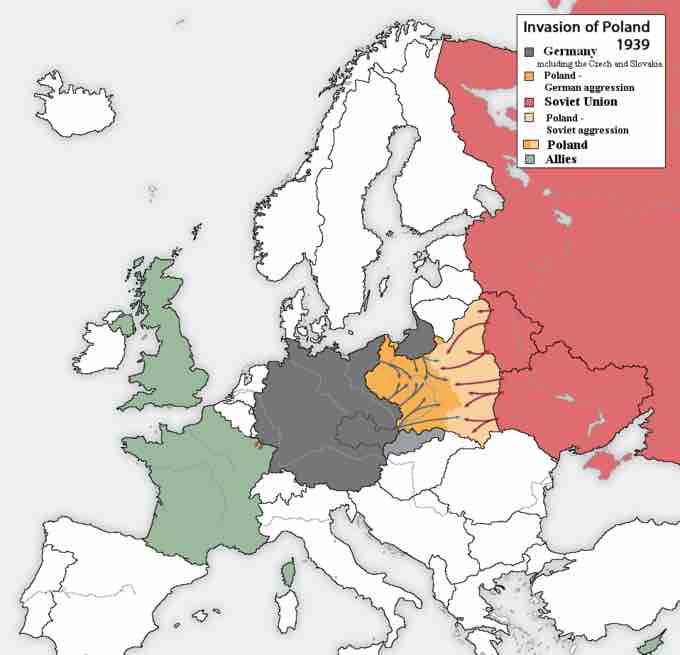The Invasion of Poland
The Invasion of Poland, also known as the September Campaign, was a joint invasion of Poland by Nazi Germany, the Free City of Danzig, the Soviet Union, and a small Slovak contingent, that marked the beginning of World War II in Europe. The German invasion began on 1 September 1939, one week after the signing of the Molotov–Ribbentrop Pact, while the Soviet invasion commenced on 17 September following the Molotov-Tōgō agreement that terminated the Russian and Japanese hostilities in the east on 16 September. The campaign ended on 6 October with Germany and the Soviet Union dividing and annexing the whole of Poland under the terms of the German-Soviet Frontier Treaty.
German forces invaded Poland from the north, south, and west the morning after the Gleiwitz incident. As the Wehrmacht advanced, Polish forces withdrew from their forward bases of operation close to the Polish–German border to more established lines of defence to the east. After the mid-September Polish defeat in the Battle of the Bzura, the Germans gained an undisputed advantage. Polish forces then withdrew to the southeast where they prepared for a long defence of the Romanian Bridgehead and awaited expected support and relief from France and the United Kingdom. While those two countries had pacts with Poland and had declared war on Germany on 3 September, in the end their aid to Poland was very limited.
The Soviet Red Army's invasion of Eastern Poland on 17 September, in accordance with a secret protocol of the Molotov–Ribbentrop Pact, rendered the Polish plan of defence obsolete. Facing a second front, the Polish government concluded the defence of the Romanian Bridgehead was no longer feasible and ordered an emergency evacuation of all troops to neutral Romania. On 6 October, following the Polish defeat at the Battle of Kock, German and Soviet forces gained full control over Poland. The success of the invasion marked the end of the Second Polish Republic, though Poland never formally surrendered.
On 8 October, after an initial period of military administration, Germany directly annexed western Poland and the former Free City of Danzig and placed the remaining block of territory under the administration of the newly established General Government. The Soviet Union incorporated its newly acquired areas into its constituent Belarusian and Ukrainian republics, and immediately started a campaign of sovietization. In the aftermath of the invasion, a collective of underground resistance organizations formed the Polish Underground State within the territory of the former Polish state. Many of the military exiles that managed to escape Poland subsequently joined the Polish Armed Forces in the West, an armed force loyal to the Polish government in exile.

The Invasion of Poland
This map shows the beginning of World War II in September 1939 in a European context. The Second Polish Republic, one of the three original allies of World War II was invaded and divided between the Third Reich and Soviet Union, acting together in line with the secret protocol of the Molotov-Ribbentrop Pact, dividing Central and Eastern Europe between the two countries. The Polish allies of that time were France and Great Britain.
Details of September 1 Invasion
Following several German-staged incidents (like the Gleiwitz incident, a part of Operation Himmler), which German propaganda used as a pretext to claim that German forces were acting in self-defence, the first regular act of war took place on 1 September 1939, at 04:40, when the Luftwaffe attacked the Polish town of Wieluń, destroying 75% of the city and killing close to 1,200 people, most of them civilians. This invasion subsequently began World War II. Five minutes later, the old German pre-dreadnought battleship Schleswig-Holstein opened fire on the Polish military transit depot at Westerplatte in the Free City of Danzig on the Baltic Sea. At 08:00, German troops—still without a formal declaration of war issued—attacked near the Polish town of Mokra. The Battle of the Border had begun. Later that day, the Germans attacked on Poland's western, southern and northern borders, while German aircraft began raids on Polish cities. The main axis of attack led eastwards from Germany proper through the western Polish border. Supporting attacks came from East Prussia in the north, and a co-operative German-Slovak tertiary attack by units from German-allied Slovakia in the south. All three assaults converged on the Polish capital of Warsaw.
Invasion of Poland
Soldiers of the German Wehrmacht tearing down the border crossing between Poland and the Free City of Danzig, 1 September 1939.
War Erupts
Two days later, on 3 September, after a British ultimatum to Germany to cease military operations was ignored, Britain and France, followed by the fully independent Dominions of the British Commonwealth—Australia (3 September), Canada (10 September), New Zealand (3 September), and South Africa (6 September)—declared war on Germany. However, initially the alliance provided limited direct military support to Poland, consisting of a cautious, half-hearted French probe into the Saarland.
The German-French border saw only a few minor skirmishes, although the majority of German forces, including 85% of their armoured forces, were engaged in Poland. Despite some Polish successes in minor border battles, German technical, operational and numerical superiority forced the Polish armies to retreat from the borders towards Warsaw and Lwów. The Luftwaffe gained air superiority early in the campaign. By destroying communications, the Luftwaffe increased the pace of the advance which overran Polish airstrips and early warning sites, causing logistical problems for the Poles. Many Polish Air Force units ran low on supplies, 98 of their number withdrew into then-neutral Romania. The Polish initial strength of 400 was reduced to just 54 by 14 September and air opposition virtually ceased.
The Western Allies also began a naval blockade of Germany, which aimed to damage the country's economy and war effort. Germany responded by ordering U-boat warfare against Allied merchant and warships, which was to later escalate into the Battle of the Atlantic.